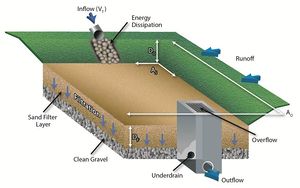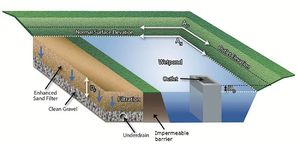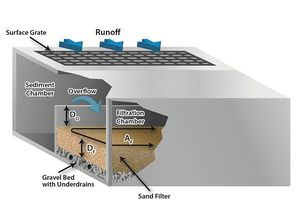
Difference between revisions of "Calculating credits for sand filter"
m |
m |
||
| Line 69: | Line 69: | ||
*EMC<sub>TP</sub> is the event mean concentration for total phosphorus in runoff, in milligrams per liter. | *EMC<sub>TP</sub> is the event mean concentration for total phosphorus in runoff, in milligrams per liter. | ||
| − | Sand filters only receive DP credit if iron is incorporated in the filter media. Information on phosphorus removal fractions (percentages) can be found [http://stormwater.pca.state.mn.us/index.php/Information_on_pollutant_removal_by_BMPs here]. Recommended values are 0.91 for R<sub>PP</sub>, 0 for R<sub>DP</sub> when no iron is incorporated into the sand filter, and 0.27 for R<sub>DP</sub> when iron is incorporated into the sand filter. | + | Sand filters only receive DP credit if [http://stormwater.pca.state.mn.us/index.php/Iron_enhanced_sand_filter_%28Minnesota_Filter%29 iron] is incorporated in the filter media. Information on phosphorus removal fractions (percentages) can be found [http://stormwater.pca.state.mn.us/index.php/Information_on_pollutant_removal_by_BMPs here]. Recommended values are 0.91 for R<sub>PP</sub>, 0 for R<sub>DP</sub> when no iron is incorporated into the sand filter, and 0.27 for R<sub>DP</sub> when iron is incorporated into the sand filter. |
| − | Annual TP Credit for iron-enhanced sand filters is dependent on the ratio of the fraction of annual runoff volume treated by the BMP. This fraction can be calculated using the [http://stormwater.pca.state.mn.us/index.php/MIDS_calculator Minimal Impact Design Standards (MIDS) calculator] or other models. For a 1 inch water quality volume, as required by the construction stormwater permit, the fraction of annual volume captured by the BMP is about 0.90 (90 percent). | + | Annual TP Credit for iron-enhanced sand filters is dependent on the ratio of the fraction of annual runoff volume treated by the BMP. This fraction can be calculated using the [http://stormwater.pca.state.mn.us/index.php/MIDS_calculator Minimal Impact Design Standards (MIDS) calculator] or other models. For a 1 inch [[Glossary#W|water quality volume]], as required by the [http://stormwater.pca.state.mn.us/index.php/III._STORMWATER_DISCHARGE_DESIGN_REQUIREMENTS#III.D._PERMANENT_STORMWATER_MANAGEMENT_SYSTEM construction stormwater permit], the fraction of annual volume captured by the BMP is about 0.90 (90 percent). |
Revision as of 19:58, 5 May 2015
This site is under construction. Anticipated completion date is May, 2015.
Credit refers to the quantity of stormwater or pollutant reduction achieved either by an individual BMP or cumulatively with multiple BMPs. Stormwater credits are a tool for local stormwater authorities who are interested in
- providing incentives to site developers to encourage the preservation of natural areas and the reduction of the volume of stormwater runoff being conveyed to a best management practice (BMP);
- complying with permit requirements, including antidegradation (see [1]; [2]);
- meeting the MIDS performance goal; or
- meeting or complying with water quality objectives, including Total Maximum Daily Load (TMDL) Wasteload Allocations (WLAs).
This page provides a discussion of how sand filter practices can achieve stormwater credits.
Contents
Overview
Sand Filters are filtration practices that use sand media to filter and remove pollutants from stormwater before entering the downstream stormwater system or BMP. Enhanced Sand Filters, also known as iron enhanced sand filters or Minnesota Filters, use iron mixed with the filter media to improve removal of dissolved constituents from the stormwater. Common types of sand filters are perimeter filters, surface filters, or underground filters. Enhanced sand filters are commonly implemented as filtration basins, or as filtration benches for wet ponds. Because sand filters are not designed to infiltrate or store stormwater, all filters require use of an underdrain to convey treated stormwater out of the system.
Pollutant Removal Mechanisms
Sand filters primarily remove pollutants through settling and filtration of solids, whereas enhanced sand filters also remove pollutants through chemical binding. Additionally, surface sand filters that incorporate vegetation into the practice will provide biological removal of nutrients via uptake by the vegetation (WEF, Design of Urban Stormwater Controls). While enhanced sand filters are effective in screening solids, the primary water quality benefits they provide are the removal of dissolved constituents including metals and phosphates. Sand filters and enhanced sand filters are not designed to infiltrate and therefore do not provide stormwater volume reduction benefits. See Section 3, Other Pollutants, for a complete list of other pollutants addressed by sand filters and enhanced sand filter practices.
Location in the Treatment Train
Stormwater Treatment Trains are comprised of multiple Best Management Practices that work together to minimize the volume of stormwater runoff, remove pollutants, and reduce the rate of stormwater runoff being discharged to Minnesota wetlands, lakes and streams. Under the Treatment Train approach, stormwater management begins with simple methods that prevent pollution from accumulating on the land surface, followed by methods that minimize the volume of runoff generated and is followed by Best Management Practices that reduce the pollutant concentration and/or volume of stormwater runoff. Sand filters may be used in a treatment sequence as pretreatment for other structural controls, or as a stand-alone BMP.
Methodology for calculating credits
This section describes the basic concepts and equations used to calculate credits for Total Suspended Solids (TSS) and Total Phosphorus (TP). Specific methods for calculating credits are discussed later in this article. No volume credit can be obtained for sand filters or enhanced sand filters. Enhanced sand filters are effective at reducing concentrations of other pollutants including colors and metals. This article does not provide information on calculating credits for pollutants other than TSS and phosphorus, but references are provided that may be useful for calculating credits for other pollutants.
Assumptions and approach
In developing the credit calculations, it is assumed the sand filter practice is properly designed, constructed, and maintained in accordance with the Minnesota Stormwater Manual. If any of these assumptions is not valid, the BMP may not qualify for credits or credits should be reduced based on reduced ability of the BMP to achieve pollutant reductions. For guidance on design, construction, and maintenance, see the appropriate article within the sand filter section of the Manual.
In the following discussion, the water quality volume (WQV) is delivered instantaneously to the BMP. The WQV is stored as water ponded above the filter media and below the overflow point in the BMP. The WQV can vary depending on the stormwater management objective(s). For construction stormwater, the water quality volume is 1 inch off new impervious surface. For Minimal Impact Design Standards (MIDS), the WQV is 1.1 inches.
Volume credit calculations
Sand filters and enhanced sand filters do not provide water quantity control, and therefore no volume credit is given.
Total suspended solid (TSS) credits
The water quality credits for enhanced sand filters are based on the treatment volume capacity of the volume of filtered water (VF). The treatment volume is assumed to be the volume of water that can be stored above the filter media. this is an event-based volume.
\( V_F = 0.5\ D_o\ (A_O + A_S) \)
where
- Do is the depth of water between overflow outlet structure and the sand filter media surface, in feet;
- AO is the surface area of the sand filter at the basin overflow, in square feet; and
AS is the area at the surface of the filter media, in square feet.
For a sand filter bench, in which a permanent pool is maintained in a wet pond, VF is calculated as the depth between the overflow and the normal water level of the wet pond.
The annual volume filtered can be determined with appropriate modeling tools.
The event-based TSS credit for sand filters, MTSS in pounds, is given by
\( M_{TSS} = 0.0000624\ R_{TSS}\ EMC_{TSS}\ V_F \)
where
- RTSS is the TSS removal fraction for sand filters,
- EMCTSS is the event mean concentration of TSS in runoff, in milligrams per liter, and
- 0.0000624 is a conversion factor.
If the sand filter is not the upstream most BMP in the treatment train, EMCTSS should be dependent on the MTSS effluent from the next upstream tributary BMP. Information on EMCs for TSS can be found here. Information on pollutant removal can be found here. The recommended pollutant removal value (RTSS) for sand filters is 0.85.
Total phosphorus (TP)
TP reduction credit is made up of 55 percent particulate phosphorus (PP) and 45 percent dissolved phosphorus (DP) removal through filtered stormwater. The event-based TP removal, MTP in pounds, is given by
\( M_{TP} = 0.0000624\ ((0.55\ R_{PP})\ + (0.45\ R_{DP}))\ EMC_{TP}\ V_F \)
where
- RPP is the removal fraction for particulate phosphorus,
- RDP is the removal fraction for dissolved phosphorus., and
- EMCTP is the event mean concentration for total phosphorus in runoff, in milligrams per liter.
Sand filters only receive DP credit if iron is incorporated in the filter media. Information on phosphorus removal fractions (percentages) can be found here. Recommended values are 0.91 for RPP, 0 for RDP when no iron is incorporated into the sand filter, and 0.27 for RDP when iron is incorporated into the sand filter.
Annual TP Credit for iron-enhanced sand filters is dependent on the ratio of the fraction of annual runoff volume treated by the BMP. This fraction can be calculated using the Minimal Impact Design Standards (MIDS) calculator or other models. For a 1 inch water quality volume, as required by the construction stormwater permit, the fraction of annual volume captured by the BMP is about 0.90 (90 percent).


